#Al Gay photographer
Text
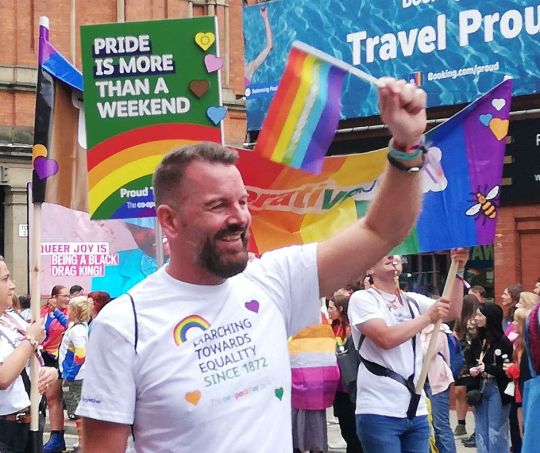
Since the 1980s, fundraising events have been held over the August bank holiday weekend in Manchester, England, in a bid to raise money for LGBTQ+ causes.
Manchester Pride kicked off on Friday 25th August 2023, the annual Pride parade was held on Saturday 26th and celebrations concluded on Monday 28th.
#manchester#photography#media#uk#hussein al-alak#photograph#picture#happy pride 🌈#pride#gay pride#uk photography
0 notes
Text
Queer Calendar 2023
We put together a calendar of key (mostly queer) dates at the start of the year to help us with scheduling - so I thought I’d share it around! Including pride and visibility days, some queer birthdays and anniversaries, and a few other bits and bobs. Click the links for more info - I dream one day of having a queer story for every day of the year!
This is obviously not an exhaustive list - if I’ve overlooked something important to you, feel free to add it in the reblogs!
January
3 - Bisexual American jazz-age heiress Henrietta Bingham born 1901
8 - Queer Australian bushranger Captain Moonlite born 1845; gay American art collector Ned Warren born 1860
11 - Pennsylvania celebrates Rosetta Tharpe Day in honour of bisexual musician Rosetta Tharpe
12 - Japanese lesbian author Nobuko Yoshiya born 1896
22 - Lunar New Year (Year of the Rabbit)
24 - Roman emperor Hadrian, famous for his relationship with Antinous, born 76CE; gay Prussian King Frederick the Great born 1712
27 - International Holocaust Remembrance Day
February
LGBT+ History Month (UK, Hungary)
Black History Month (USA and Canada)
1 - Feast of St Brigid, a saint especially important to Irish queer women
5 - Operation Soap, a police raid on gay bathhouses in Toronto, Canada, spurs massive protests, 1981
7 - National Black HIV/AIDS Awareness Day (USA)
18 - US Black lesbian writer and activist Audre Lorde born 1934
12 - National Freedom to Marry Day (USA)
19-25 - Aromantic Spectrum Awareness Week
March
Women’s History Month
1 - Black Women in Jazz and the Arts Day
8 - International Women’s Day
9 - Bi British writer David Garnett born 1892
12 - Bi Polish-Russian ballet dancer Vaslav Nijinsky born 1889 or 1890
13 March-15 April - Deaf History Month
14 - American lesbian bookseller and publisher Sylvia Beach born 1887
16 - French lesbian artist Rosa Bonheur born 1822
20 - Bi US musician Rosetta Tharpe born 1915
21 - World Poetry Day
24 - The Wachowski sisters’ cyberpunk trans allegory The Matrix premiers 1999
April
Jazz Appreciation Month
Black Women’s History Month
National Poetry Month (USA)
3 - British lesbian diarist Anne Lister born 1791
8 - Trans British racing driver and fighter pilot Roberta Cowell born 1918
9 - Bi Australia poet Lesbia Harford born 1891; Easter Sunday
10 - National Youth HIV & AIDS Awareness Day (USA)
14 - Day of Silence
15 - Queer Norwegian photographer and suffragist Marie Høeg born 1866
17 - Costa-Rican-Mexican lesbian singer Chavela Vargas born 1919
21-22 - Eid al-Fitr
25 - Gay English King Edward II born 1284
26 - Lesbian Day of Visibility; bi American blues singer Ma Rainey born 1886
29 - International Dance Day
30 - International Jazz Day
May
1 - Trans British doctor and Buddhist monk Michael Dillon born 1915
7 - International Family Equality Day
7 - Gay Russian composer Pyotr Tchaikovsky born 1840
15 - Australian drag road-trip comedy The Adventures of Priscilla, Queen of the Desert premiers in 1994
17 - IDAHOBIT (International Day Against Homophobia, Biphobia, Intersexism and Transphobia)
18 - International Museum Day
19 - Agender Pride Day
22 - US lesbian tailor and poet Charity Bryant born 1777
22 - Harvey Milk Day marks the birth of gay US politician Harvey Milk 1930
23 - Premier of Pride, telling the story of the 1980s British activist group Lesbians and Gays Support the Miners
24 - Pansexual and Panromantic Awareness and Visibility Day; Queer Chinese-Japanese spy Kawashima Yoshiko born 1907
26 - queer American astronaut Sally Ride born 1951
29 - Taiwanese lesbian writer Qiu Miaojin born 1969
June
Pride Month
Indigenous History Month (Canada)
3 - Bisexual American-French performer, activist and WWII spy Josephine Baker born 1906
5 - Queer Spanish playwright and poet Federico García Lorca born 1898; bi English economic John Maynard Keynes born 1883
8 - Mechanic and founder of Australia’s first all-female garage, Alice Anderson, born 1897
10 - Bisexual Israeli poet Yona Wallach born 1944
12 - Pulse Night of Remembrance, commemorating the 2012 shooting at the Pulse nightclub, Orlando
14 - Australian activists found the Gay and Lesbian Kingdom of the Coral Sea Islands in 2004
18 - Sally Ride becomes the first know queer woman in space
24 - The first Sydney Mardi Gras 1978
25 - The rainbow flag first flown as a queer symbol in 1978
28 - Stonewall Riots, 1969
28 June-2 July - Eid al-Adha
30 - Gay German-Israeli activist, WWII resistance member and Holocaust survivor Gad Beck born 1923
July
1 - Gay Dutch WWII resistance fighter Willem Arondeus killed - his last words were “Tell the people homosexuals are no cowards”
2-9 - NAIDOC Week (Australia) celebrating Aboriginal and Torres Strait Islander culture
6 - Bi Mexican artist Frida Kahlo born 1907
12 or 13 - Roman emperor Julius Caesar born c.100BCE
14 - International Non-Binary People’s Day
23 - Shelly Bauman, owner of Seattle gay club Shelly’s Leg, born 1947; American lesbian cetenarian Ruth Ellis born 1899; gay American professor, tattooist and sex researcher Sam Steward born 1909
25 - Italian-Australian trans man Harry Crawford born 1875
August
8 - International Cat Day
9 - Queer Finnish artist, author and creator of Moomins Tove Jansson born 1914
9 - International Day of the World's Indigenous Peoples
11 - Russian lesbian poet Sofya Parnok born 1885
12 - Queer American blues musician Gladys Bentley born 1907
13 - International Left-Handers Day
22 - Gay WWII Dutch resistance fight Willem Arondeus born 1894
24 - Trans American drag queen and activist Marsha P Johnson born 1945
26 - National Dog Day
30 - Bi British author Mary Shelley 1797
31 - Wear it Purple Day (Australia - queer youth awareness)
September
5 - Frontman of Queen Freddie Mercury born 1946
6 - Trans Scottish doctor and farmer Ewan Forbes born 1912
13 - 1990 documentary on New York’s ball culture Paris is Burning premiers
15-17 - Rosh Hashanah
16-23 - Bisexual Awareness Week
17 - Gay Prussian-American Inspector General of the US Army Baron von Steuben born 1730
23 - Celebrate Bisexuality Day
24 - Gay Australian artist William Dobell born 1889
30 - International Podcast Day
October
Black History Month (Europe)
4 - World Animal Day
5 - National Poetry Day (UK)
5 - Queer French diplomat and spy the Chevalière d’Éon born 1728
8 - International Lesbian Day
9 - Indigenous Peoples’ Day (USA)
11 - National Coming Out Day
16 - Irish writer Oscar Wilde born 1854
18 - International Pronouns Day
22-28 - Asexual Awareness Week
26 - Intersex Awareness Day
31 - American lesbian tailor Sylvia Drake born 1784
November
8 - Intersex Day of Remembrance
12 - Diwali; Queer Mexican nun Sor Juana Inés de la Cruz born c.1648
13-19 - Transgender Awareness Week
20 - Trans American writer, lawyer, activist and priest Pauli Murray born 1910; Transgender Day of Remembrance
27 - Antinous, lover of the Roman emperor Hadrian, born c.111; German lesbian drama Mädchen in Uniform premiers, 1931
29 - Queer American writer Louisa May Alcott born 1832
December
AIDS Awareness Month
1 - World AIDS Day
2 - International Day for the Abolition of Slavery
3 - International Day of Persons with Disabilities
8 - Pansexual Pride Day; queer Swedish monarch Christina of Sweden born 1626
10 - Lesbians and Gays Support the Miners host Pits and Perverts concern to raise mining for striking Welsh miners, 1984
14 - World Monkey Day
15 - Roman emperor Nero born 37CE
24 - American drag king and bouncer Stormé DeLarverie born 1920
25 - Christmas
29 - Trans American jazz musician Billy Tipton born 1914
#calendar#queer calendar#queer observances#pride days#queer history#lgbt#lgbtq#lgbt history#gay history#trans history#queer#gay#trans#lesbian#lesbian history
252 notes
·
View notes
Text
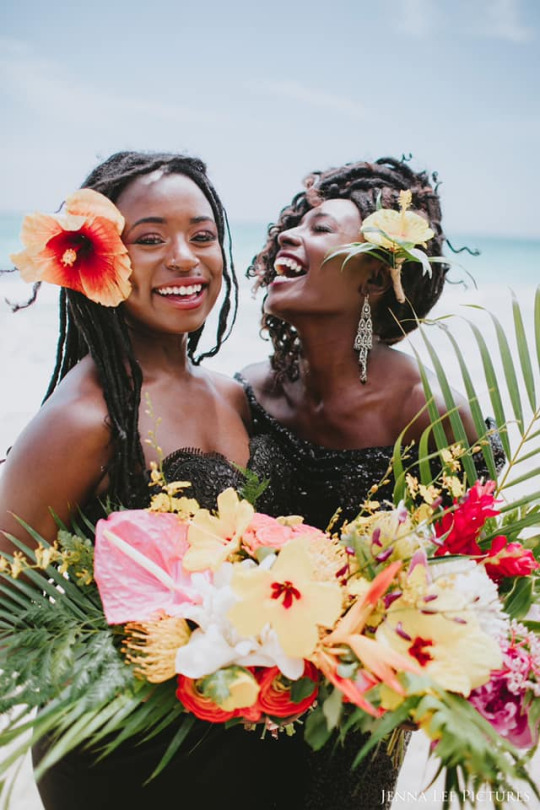
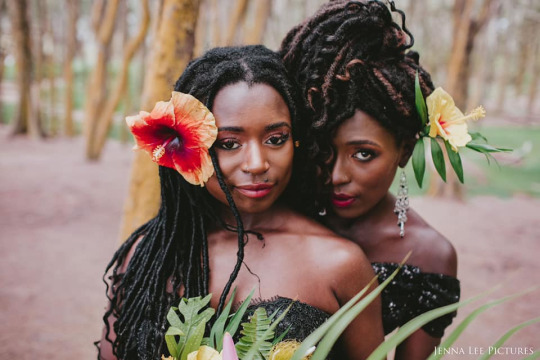








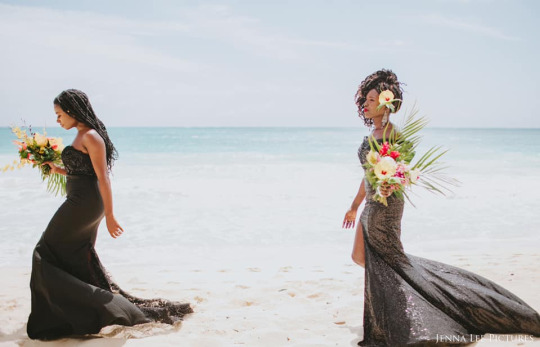
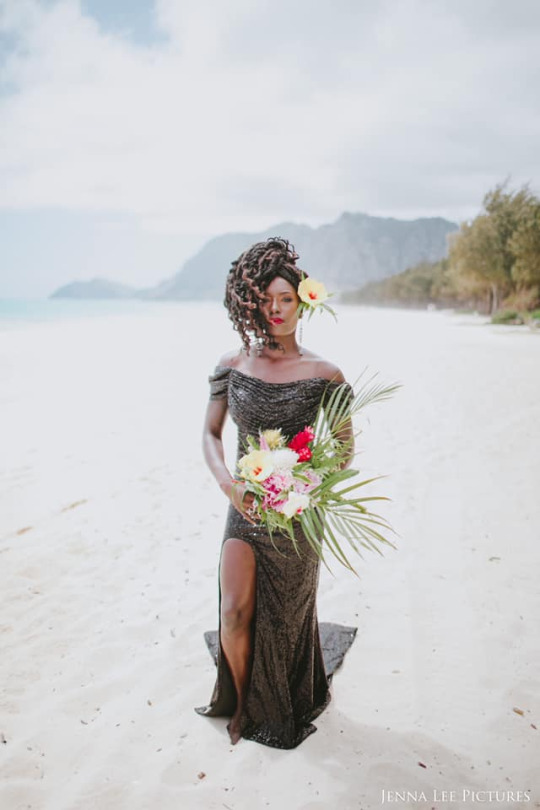

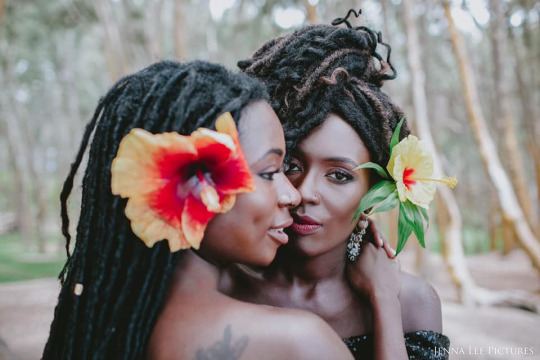




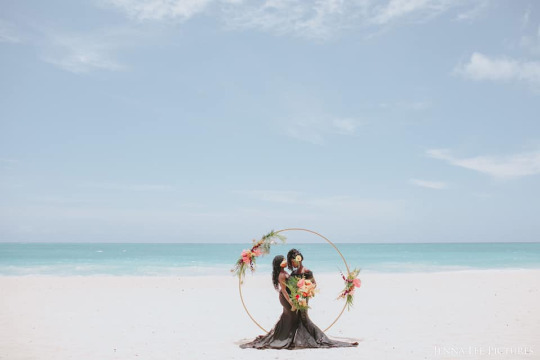
Amy Benson
eorsndSopt76 9am1t2lua1m50l6i532hm9t26Je,0m ilg8fnl2lla0l0c4
·
“Amy, are you A GAY?” I could hear my mother’s Nigerian accent in my head while I was swooning over these photos. It made me super weak with laughter as I envisioned her being utterly confused about what exactly queer means.
Here’s the thing, Nigerian parents have a way of ignoring things that they don’t want to know the answer to or already know the answer to but don’t want to acknowledge or discuss it.
Before getting “left on read” was a thing on social media or via text, Nigerian parents had already mastered this art.
Curating and maintaining privacy while being explosively socially active is a life skill I should add to my resume. It’s been by choice and design until love happened to me. Like love love.
And besides, these photos are honestly too beautiful not to share sooo.....
SHE is Her:
I’ve fallen deeply in love with a woman. Although she’s not the first woman I’ve been intimate with, in the past I’ve consciously steered clear of relationships with women. “Nah, I don’t date women.” I’ll be honest, anything more than physical seemed “too gay” for me. Whatever that means. Chileeee I’m already unpacking that. I’ll report back when that “luggage” is empty, “clothes” are folded, and all are stored away.
SHE has allowed me to be more vulnerable, transparent, and even more expressive than I was before. Her beauty is enamoring, her touch is intoxicating, and she sings a song that puts my soul at ease. Bae can sang sang. She melts my heart...her dimples are wide and deep enough for me to find comfort in. Although I find comfort in her extraordinary culinary abilities, her dimples don’t come with calories. Lol.
She’s sweet. Supportive. Sensible. Smart. Sexy. SHE
IS
EVERYTHING
She’s so damn bomb y’all.
Additionally, she continuously encouraged me during the start of my business, Planes and Champagne Hawaii, a lifestyle concierge company. (shameless plug
)
But all FACTS.
I also understand her love language is quality time and I haven’t succeeded in that department while laying a foundation to not only entrepreneurship, but a beginning to a forever with her.
The Photoshoot
The number of people that reached out and was like, “Amy, so you got married without having a lit ass wedding that we could come turn up at?!!” The fact y’all know my wedding would be lit af makes my heart burst into champagne bubbles. I love y’all so hard.
Calm down, we did not get married. You did not miss a lit ass wedding in Hawaii. Most importantly, you did not miss the open bar.
Vida Chic Events reached out to me and stated they wanted to capture me and bae in a wedding style shoot at one of the island’s most beautiful beaches with the infamous wedding photographer Jenna Lee. Jenna Lee is almost never available but the universe aligned and she was free on Juneteenth. Crazy right?! Oh the universe.
Chavah Grant, owner of Vida Chic Events, literally coordinated this magical production in approximately 5 days. She told me she wanted to do BLACK gowns, colorful flowers, white sand...I was like, “oh so this is going to be lit lit.” Got it sis.
I called my makeup artist friend Andrea right away and made an appointment for her to come beat our faces to the GAWDS.
And Sis
deliverdt
. Beatith to the horizons of the Melanated Gods
Love you Drea
I was slightly concerned Jenna, despite her impressive portfolio, wouldn’t capture our melanin properly. Sometimes vvhite photographers don’t give our glow the GLORY it deserves.
But she DEFINITELY delivered ! Whew.
So here I was... me and somebody’s daughter, ..somebody’s FINE AF daughter, getting photographed by Jenna Lee, with rings on from The Wedding Ring Shop, gowns from White Hot Hawaii, adorned with flowers from Ocean Dreamerr along a white sand beach on Oahu. Damien Marley’s “Beach in Hawaii” playing in my head...
A dream...a freaking dream.
I was nervous yet anxious and excited to write this. She deserves for me to love her out loud on Al Gore’s innanet.
This is me loving Victoria out loud. When she reads this, she’s likely going to bat her eyes with them long ass lashes she loves, with a smile so divine, and eyes that say, “I’m yours.”
Nourish the love you have. And until love happens to you, please believe You. Are. Enough. Aloha
Share and Tag someone. Let them know you love them. Love them out loud.
Amy Benson
IG: @planesandchampagne_808
FB:
https://m.facebook.com/planesandchampagne
Web:
www.planesandchampagne.com
Victoria Salter
IG: @elisabeth.kitchen
Photographer
Instagram/ pinterest/ twitter @jennalepics
FB: @Jenna Lee Pictures
Web:
www.jennaleepictures.com
Rentals,Design,Coordinator
IG: @vidachicevents
FB:
https://www.facebook.com/vidachicevents/
Web:
https://linktr.ee/vidachicevents
Makeup Artist
Andrea Huff
IG: @dreamfacethemua
Attire
IG: @whitehothawaii
Rings
IG:@weddingringshop
Flowers
IG: @ocean_dreamerr
Just Married Jacket
IG:@thesimpleflourish
Drink Markers
IG: @picturesque_love_ See less
#goth beach wedding#queer poc#black lgbtq#black lesbian wedding#black bisexual wedding#queer#queer wedding#beach wedding#goth wedding dress#gothic wedding dress
20 notes
·
View notes
Text

(GO TO PART 1 AND PART 3)
PART 2
60. In chapter 23, it’s finally revealed that Javier now works for a charity on the Texas-Mexico border. This idea has been in my head for over a year, as can be seen from the below notes I made to myself in February/March 2023:
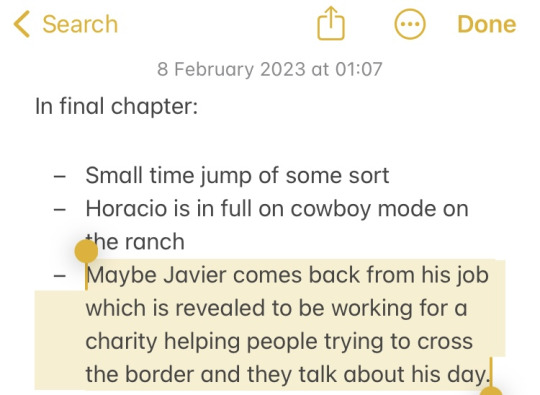
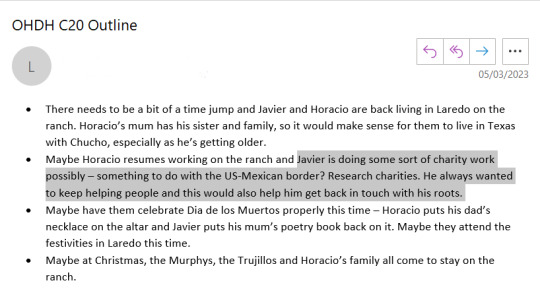
Strangely, I then read Infinite Country by Patricia Engel (referred to above at point 50) in early May 2023, which contains the following passage:

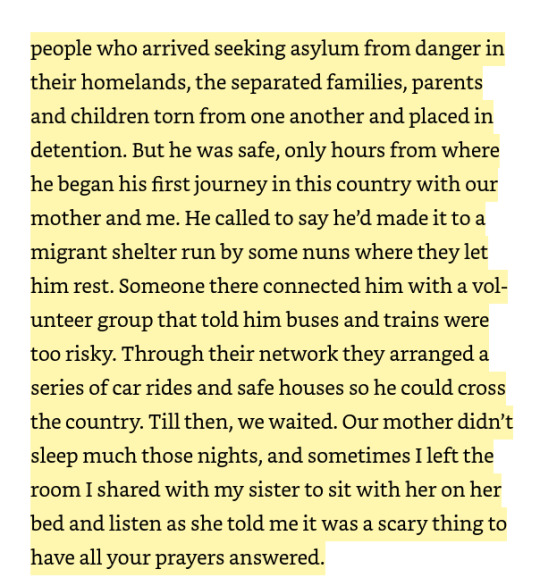
So, that made me even more determined to go down this path with Javier ❤️
I won’t list all of the different charities/not-for-profits/NGOs I researched, but there are some mentioned here plus Border Angels and Al Otro Lado. Not all of them are Texas-based, but they do operate somewhere along or near the US-Mexican border, so I used a mix of them as inspiration.
61. Horacio’s route to getting a visa and green card in chapter 23 was largely based on the real-world EB5 visa. Although, I may have taken slight liberties for the purposes of the story (it was hard to see any other real life route for Horacio to actually be granted a long term visa/green card to be honest…which is apt for other themes of this chapter), so it’s not 100% accurate to real life lol.
62. There are several references in chapter 23 to America’s sodomy laws that were still in place in some states, including Texas, by 1997 (when chapter 23 is set), but it wasn’t until the landmark Supreme Court case of Lawrence vs Texas in 2003 that it was ruled sodomy laws in Texas and various other states were unconstitutional.
For further reading on the queer rights movement (and the violence and harassment queer Texans faced) that paved the way for Lawrence vs Texas, I highly recommend Before Lawrence v. Texas: The Making of a Queer Social Movement by Wesley G Phelps
63. If you wondered what a lariat was in chapter 23, it’s the rope cowboys use to lasso (‘lasso’ is actually the verb, whereas the rope itself is called a ‘lariat’, which comes from the Spanish word la reata, meaning to catch or fasten).
There’s also a reference to a quirt, which is a short leather whip used by cowboys to encourage their horse to go faster.
64. As for the sex scene in chapter 23…eagle-eyed readers may have spotted the foreshadowing for this in chapter 20 😉 A long while before I even wrote chapter 20, I’d had Horacio wearing a harness in my head (these are things that live in my brain rent free, apparently lol), largely influenced by this Tumblr post and the gay leather movement. Speaking of which…the references to Drummer relate to a real gay leather magazine that exists in the US.
I made up the part about the harness instructions and a cowboy/rodeo special, however, there is a website with scans of old issues…and lo and behold, there was a cowboy special (WARNING FOR HIGHLY NSFT/W CONTENT).
There’s also a fascinating interview here with ‘Cowboy Frank’ who created the above archive of gay magazines as a tribute to his late husband.
65. Keeping on the theme of gay cowboys…gay rodeo is a real thing in Texas. You can read more about it here, here, here, here and there are some photographs here too.
I also have Slapping Leather: Queer Cowfolx at the Gay Rodeo by Elyssa Ford and Rebecca Scofield and Rodeo as Refuge, Rodeo as Rebellion: Gender, Race, and Identity in the American Rodeo by Elyssa Ford to read at some point (unfortunately, I didn’t get chance to read them before posting chapter 23), which look really interesting.
I couldn’t in a million years see Horacio (or Javier for that matter) taking part lol, but I wanted to at least mention its existence in chapter 23.
66. I’ve mentioned Día de Muertos above already, but here’s more about what the different items on an ofrenda represent and also a breakdown of what happens on each day of the festival.
67. La Virgen de Guadalupe, La Llorona and La Malinche are all referenced in chapter 23.
I initially got the inspiration to include the Guadalupe prayer card from these promo images of Javier. But it wasn't until I started doing more research, I discovered her links to La Llorona and La Malinche. Their identities throughout Mexican history change depending on who is telling the story (which is why Chucho lists various different names) and La Virgen de Guadalupe in particular symbolises the shift Mexico underwent after the Spanish colonisers arrived (from the religion of the Aztecs to Catholicism).
This is a strong theme in Borderlands/La Frontera: The New Mestiza by Gloria Anzaldúa and this book was a big inspiration for the conversation between Javier and Chucho about their Mexican roots.
I also found an interesting article dissecting the trio as different archetypes of women (in fact, it quotes Gloria Anzaldúa as well).
Some other related pieces about La Virgen de Guadalupe and how she relates to Mexican/Chicano identity:
Tonantzin Tlalli Coatlicue & Our Lady of Guadalupe
Commentary: The representations of La Virgen de Guadalupe show her power over identity
Celebrating Guadalupe, Sacred Icon of the People
I may have gone a bit overboard with this part of my research lol, but it was so fascinating to me, I just kept falling down different rabbit holes. And I’ve always liked the idea of Javier being caught between two worlds – in the show, and in the OHDH universe. So, this all served chapter 23 well with Javier returning to Laredo and trying to connect the different parts of his identity.
68. Operation Gatekeeper and Operation Hold the Line are referenced in chapter 23. These were two anti-immigration initiatives in the early ‘90s which involved the militarisation of the US-Mexican border with an increase in Border Patrol staff, the introduction of checkpoints and the building of physical walls.
69. Javier references new immigration legislation in chapter 23. ‘IIRIRA’ is the Illegal Immigration Reform and Immigrant Responsibility Act 1996, which came into effect on 1st April 1997.
It was yet more harsh anti-immigration measures that widened the remit for people to be removed, deported and banned from the US. Here’s an article about the problems the legislation caused.
Ironically, whilst America was doing everything it could to keep people from crossing the border, the passing of NAFTA in 1994 actually made drug trafficking across the border easier and exacerbated cartel-related violence in Mexico.
Whilst on the subject of US immigration, there is also a reference to the ‘INS’ in chapter 23, which was the predecessor to ‘ICE’ (ICE was formed in 2003, so it would still have been INS in 1997).
70. Towards the end of chapter 23, when Javier and Horacio are snuggled under a mesquite tree and talk about a story they read in The New Yorker, it was, of course, Brokeback Mountain by Annie Proulx, which was first published in TNY as a short story on 6th October 1997.
I had to fit a reference to it in this fic somewhere lol. Although, for as much as that story influenced OHDH in places, I like to think Javier’s and Horacio’s ending is the antithesis to the ending of Brokeback Mountain ❤️
71. At the end of chapter 23, various artists are mentioned as appearing on their bookshelves. I’ve picked out either titles of significance or reasons for why they’re referenced:
Our Lady of the Assassins (La Virgen de los sicarios) by Fernando Vallejo (A gay Medellín-born author writing semi-autobiographically about a gay man living in Medellín during the worst years of violence…I don’t think I need to explain further why this is on the list lol)
Maurice by E.M. Forster and also the film adaptation (A gay romance with a relatively happy ending for a change)
City of Night by John Rechy (Follows a gay Texan man’s journey and sexual encounters across America)
Gloria E. Anzaldúa (See point 67 above)
Alejo Durán (Colombian Vallenato musician – and cowboy)
Long, Long Time by Linda Ronstadt (If you’ve seen The Last of Us, you’ll know why I chose this. If you haven’t seen it, please make a point of watching season 1, episode 3 as it’s one of the most beautiful queer love stories I’ve ever witnessed 😭)
Drag by K.D. Lang (A covers album by a lesbian musician of songs centred around smoking…again, I don’t think I need to explain any further lol)
Para Siempre by Vicente Fernández (A Mexican ranchera singer…just look at the lyrics for Para Siempre and sigh longingly)
Preface to Leaves of Grass by Walt Whitman (Specifically for this quote, because I stumbled across it by accident and it fit so many themes of the fic:
“Past and present and future are not disjoined but joined. The greatest poet forms the consistence of what is to be from what has been and is. He drags the dead out of their coffins and stands them again on their feet….he says to the past, Rise and walk before me that I may realize you. He learns the lesson….he places himself where the future becomes present.”)
Pedro Almodóvar (A Spanish gay film director I’ve mentioned above somewhere before…and also coincidentally worked with Pedro Pascal in Strange Way of Life)
The Living End written and directed by Gregg Araki (Just a couple of gay HIV Positive guys on a road trip)
72. The end scene of them dancing together was largely inspired by two things:
This gorgeous, gorgeous piece of artwork (artist at the link).
And this scene in Fellow Travelers.
I had originally intended to end chapter 23 like the artwork, but after watching Fellow Travelers in December 2023, I had to write my own nod to possibly one of the most intimate scenes I’ve ever seen committed to camera. I swear it re-wired my brain chemistry.
And it’s funny, because I hadn’t actually read or even heard of Fellow Travelers by Thomas Mallon when starting OHDH, but there are so many delightful parallels (e.g. Tim and his cross necklace/religious guilt and the Dom/sub undertones, all of their dancing, the switching in power dynamics during sex as a way to show vulnerability…I just couldn’t help but imagine Horacio/Javier in all the Hawk/Tim sex scenes).
73. A few other books/articles I read for chapter 23 research that I haven’t mentioned already:
Farm Boys: Lives of Gay Men from the Rural Midwest by Will Fellows
The Distance Between Us by Reyna Grande
Retablos: Stories From a Life Lived Along the Border by Octavio Solis
Where We Come From by Oscar Cásares
Brownsville: Stories by Oscar Cásares
Beyond Smoke and Mirrors: Mexican Immigration in an Era of Economic Integration by Douglas S. Massey, Jorge Durand and Nolan J. Malone
In the Valley of Mirrors by Antonio Ruiz-Camacho
Out West, the Gay Cowboy Roams Free by Evan Moffitt (New York Times article transcribed on my Tumblr)
2 notes
·
View notes
Text
AU List
a lovely anon asked if I had a list and the answer was no, so now I've made one and honestly you lot need to stop me
- sebson driver dads** (Sebson, Lando/George)
- summer job** (Pando)
- university** (Pando)
- firehouse** (Mickdo)
- coffee shop mafia (Pando)
- spy (Charpando)
- mercenary* (Dando)
- werewolf (Pando)
- grid kid Lando
- dj gremlin, old man stripper (Dando)
- omega/omega (Pando, Maxiel)
- gamer boys (Pando)
- royalty (Charlando)
- model Pierre/F1 Lando (Pando)
- football au (Charlando)
- single dad Max, gang Daniel (Maxiel with baby Lando)
- escort Lando (Lando/Everyone)
- vampire/werewolf (Charlando, Simi, Jenson/Nando/Mark)
- footballer Pierre/nobody Lando (Pando)
- knitter Lando (Dando)
- vet au (Pando)
- sort of sugar daddy (Nortrell)
- mute baker Lando (Pando)
- photographer Lando (Norstappen)
- top gun/fighter pilot (Lando/George)
- royal arranged marriage (Pando)
UPDATE:
- surfer (Dando)
- hospital meet cute (Nortrell)
- mute baker Lando (Pando)
- Max Fewtrell - F1 driver (Nortrell)
- personal trainer (Dando)
- boxer Lando (Landoscar)
- gay chicken au (Sebson with twins Lando and George)
- spicy baby au (Sebson, baby Lando, future Mickdo)
- cowboy (Dando)
- flatheads and fucked up legs (Dando)
and then some that I share with @f1-disaster-bi ~
- shifters* (Pando, et al.)
- chaos au (Markson, Simi, Nando/Lewis, Mickdo)
- paddock hoe Lando* (Lando/Everyone)
8 notes
·
View notes
Note
Lol I wasn't trying to pick a fight. When I said poorly done edits I meant by bighit editors like teleporting them and stuff 😆. I was really curious as to what made you believe in them because sometimes you have good knck of analysis that so many things makes sense. I just wanted to know if you havediff perspective. You also said in one anons ask that you prefer concrete evidence so thought I'll ask.
No worries I get sometimes it's hard to explain our beliefs.
Hi, thanks for clarifying what you meant. And yes the BigHit editors are notorious, lol, particularly pre-2020.
Whilst I can't pinpoint the moment, as it took place over several months of realising that this ship was real, I can say 2018 as a whole and what I observed was probably the key era. There are several things, when added up, started to solidify in my mind there relationship was probably more than just friends...
The Namsen Hotel Date
Taekook on 26th January were photographed at the restaurant of a Namsen hotel, about 10 mins aware from their Dorm at the time, they were along. In order to book at the hotel, reservations most be done in advance. Two months later, Jimin said this in a magazine interview:

Dispatch, Contract negotiations and the rumour of a gay couple, 2 years apart in age from the same top idol group
Back in 2016, a rumour emerged of a high profile idol group had a couple where the two were 2 years apart in age, that in Dispatch's 2017, would be the annual couple revealed by them. After this, Taekook were clearly being separated and content edited to show them as not being close. The rumour re-emerged in 2018, just as BTS's contract renewal/possibly disbandment was happening. All those rumours disappeared once the contract was renewed, and it appeared that Dispatch had a special arrangement with BTS for exclusive content. But here's the thing everytime Dispatched published anything about BTS, the featured photo would always be Taekook. And let us not forget the instagram post when Dispatched use the love hearts and the gay male couple emojis with a photo of Taekook...

Yoongi's Text to just them and the way the members talked about and treated them
During Festa 2018 (then again in a Japanese TV show, Taekook talk about receiving same a long message from Yoongi telling them he loves them. They were together when reading and supposed both cried. I found it very strange that Yoongi would need to send them both the same message unless it directly related to both of them.
youtube
youtube
Another thing that happen this year was the constant way the members would push them together, or mentioned them as being the same or different that the rest of the members, and only share playlists with each other and not the group...
Summer Package, Bon Voyage 3 & GCF
Summer Package and Saipan GCF, showed a very clingy Taekook, Tae wanting JK to do the same thing as him. The fact they went for an early morning stroll on the beach in pyjamas to film part of the GCF (something of a recurring them for them in both In the Soop and a private holiday. The, summer package was when JK challenged Tae when he called JK a friend (everything a little weird for a bit there).
Also let us not forget GCF Newark and vlive from the previous day that was suspicious.
Bon Voyage, was interesting, because 1 big thing happened at that time, Tae's grandfather passed away shortly before filming, and was the reason for his absence. Whilst, Tae was not there JK was constantly on his phone, when he arrived in Malta we barely saw it again. Then of course JK (and the teams) not so subtle way of allowing Tae to share with JK, in a double bed. There were weird things happening, like the ever depleted toilet tissue and JK's weird way of waking up, like he had something on his fingers, the cuddling and how the members tried to make a joke of it but it was not really working. Things were just odd. Then of course were the hidden moments not in BV3, like Taekook going for a stroll together and two bodyguards, only to be stopped by a Red Bull van, or the moonlight walk and drinks that only Taekook appeared to do together.
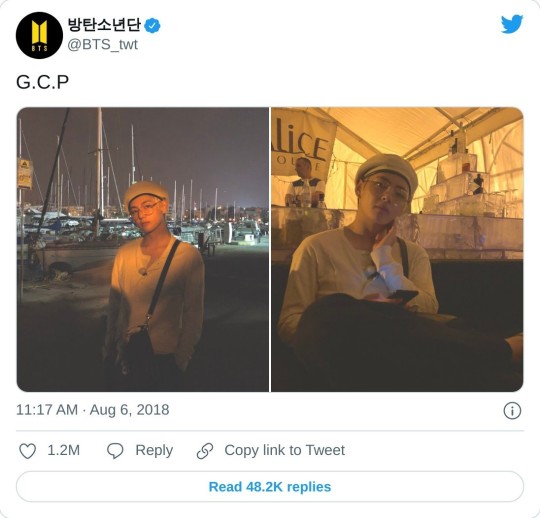

The two Taekook kisses and general clinginess.
Kiss 1 the concert nape kiss:

JK's reaction was interesting...
youtube
Then you have the exclusive fan content cheek kisses:
youtube
The reaction and what the members say is interesting, as it seems that do this sort of thing a lot in the dorm and they are also concern if they are allowed to do this...
youtube
Also this year, Taekook became very clingy...





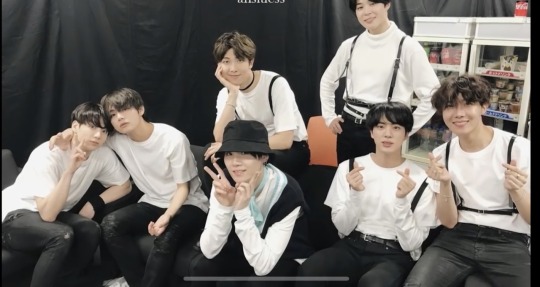

Like I said, not one thing but many that make me think... yep a couple.
About the Concrete Evidence
Regarding, concrete evidence, perhaps "concrete" isn't the correct word to use and maybe "actual" is better. All fans and shippers who create content (outside of fan fiction, of course), will focus that content on what they love. Taekookers focus the content on Tae and JK, Jikookers on JK and Jimin etc... sometimes to the point of editing out other people and additional context that gives you a bigger picture to what you're seeing.
That is why, whenever I watch a Taekook Analysis or Compilation Video, see a post on Tumblr or a Tweet that says/shows something, I'm aware that what I may be seeing is not be the whole picture or context.
So I try best to find and watch the original video, photo or tweet etc, without a Taekook fan's focus on it, so I can see the full context of what they're trying to say.
I would tell anyone to do the same with anything Taekook/BTS related posted on here. Don't just take my word for it, do your own research and make up your own mind.
26 notes
·
View notes
Text
RE8 characters saying quotes from my friends, family, coworkers, and I
Sal: "I will piss in your pants little man!"
Karl: "Titty bitch"
Karl: "That is, to date, the most idiotic thing that you have ever said to me and somehow it makes me appreciate your existence even less" (To Miranda or Alcina maybe)
Sal: "Get'cha somma that hood-ass seafood!"
Ethan: "And he had a MAAAASSIIIVE COOOOCK!!!"
Angie: "Whoosh! I stole your left testicle!" (Idk, I can just see her saying this)
Donna: "I'm going to try and photograph the gay one."
Alcina: "That's nice dear, let me know how it feels to fail at that just like everything else you do." (To Karl probably)
Karl: "@/Arbys, Just because you call it your "Arby's Sauce" doesn't mean you're going to get me to eat your cum."
Sal: "JFK is the Zodiac Killer, that's why when he was assassinated the zodiac killings stopped and also why they couldn't catch him."
Sal: "I believe in you, Adam Sandler!!!"
Donna: "Gay marriage is a good thing Brian Mother Miranda."
One of Lady D's Daughters maybe: "Jesus Mom said that I need to barricade the doorway and hang them up for a while until I get everything taken care of."
Ethan: "I'm sorry for your experience with the squirrels around the house" (to Karl)
Idk: "Feral squirrels are still wailing and you can sometimes hear them talking about the center of the universe."
Karl: "Ham and turkey, bacon and eggs, gay marriage, it's all good to me"
Alcina: "Jesus Christ Karl is the fifth one I found was a bitter hoe."
Sal: "How's 'bout them biscuits though?!" (After making food for everyone)
Karl: "Heeeey there friend, you dumb! Haha! No brain in head!" (to Sturm or a soldat probably... maybe Alcina)
Miranda: "What the hell does teabag mean? Why are you laughing? Why won't anyone tell me?"
Ethan: "*sigh* No, most seven-year-olds aren't supposed to have mustaches, Emily Rose.."
Sal: "*laughing hysterically* Fucked the corn!!! *continues laughing*"
Chris: "For the longest time I thought Layers Of Fear was a joke game about Shrek. It was a surprise to learn that it was indeed not about Shrek."
Donna: "I am no longer able to stomach apple juice because I drank like 20 of those little carton ones. In the span of 30 minutes."
Angie: "Up until like 3 years ago I didn't know Al Capone was real. I thought he was just a made-up dude from one episode of Soul Eater. I also didn't realize Billy The Kid was real but yk."
Sturm: "Every time someone rings the doorbell, I scream"
Ethan: "idk u very well but u sound like a yeehaw-cowboy"
Alcina: "*shrugs* Idk, could be gayer..."
#resident evil village#resident evil#ethan winters#karl heisenberg#re8#resident evil 8#re8village#chris redfield#resident evil angie#resident evil sturm#salvatore moreau#alcina dimitrescu#mother miranda#donna beneviento#lady ds daughters#incorrect quotes#resident evil incorrect quote#resident evil incorrect quotes#re8 incorrect quotes
54 notes
·
View notes
Text
Dearest Mr Tooker,
I’m writing you today to extend my sincerest congratulations on your coming out. I hope this was something planned by you and your boyfriend and not the result of an opportunistic photographer. especially as I know the photographer in question and would be most disappointed in him. It is a very brave thing to stand up and declare oneself to the world when you have so many eyes on you. I applaud you, and your boyfriend’s, bravery. As I’m sure you know, or have likely been told several times by now, your bravery has, I’m certain, inspired many. I hope that this congratulations is but one of many you two receive today. Please convey my best wishes to your boyfriend as well. The pair of you make a very lovely couple. During our brief acquaintance I have gotten the impression that you are very well supported. However, if you ever find yourself in need of a friendly ear, because of your new status as a gay icon or any other reasons, do know that my doors are always open. Once again best wishes and happiness to you both!
With warmest regards,
Al Cole

6 notes
·
View notes
Text
Little privacy, Jughead?


Um. Question. What the Heck is Jughead doing photographing that second "one on one" action?
And here is a curious reversal of the "fool all the girls to my old fashioned swimsuit contest so I can wear a bikini and get opted by all the guys" premises the company ran a number of times.

We don't really do the "gay 90s" anymore. No one hankers for that time, and it has receded into ancient history. I am surprised they did it in the next 90s, but I guess the writer is old. Al Hartley did his bit of social conservative political yearning for a mythical 1890s, but that was in the 1970s. Today we have to do some retrofitting and refurbish new technology into the setting to get anyone to love those times -- Steampunk.
#Don't say gay#Archie Comics#Betty Cooper#Photographs#One on one#Basketball#Masquerade#Gay 90s#Showgirl outfit#Archie Andrews#Veronica Lodge#Doug Crane#1996
9 notes
·
View notes
Text
Watching Resolution: Different from the Others (1919)
3. A silent or dialogue-free film: Different from the Others (1919)
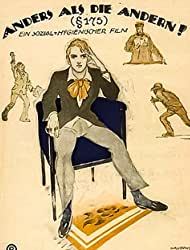
List Progress: 4/12
So much of queer history has been overlooked, erased or lost over the span of time, so what does remain is precious. Different from the Others (Anders als die Andern in the original German) is a 1919 silent film, and contains one of the first direct references to homosexuality in the history of cinema, and is almost certainly the first pro-gay film ever made. The film is a polemic, a simple and direct story making the full-throated argument that, in opposition to Germany’s Paragraph 175 law of the time, homosexuality should not be illegal and that queer people should be left alone to live their lives undisturbed. There is not a lot of nuance in the argument for modern audiences, but for people fighting for their lives, it was radical and in many ways still is today.
The film was helmed by doctor and sexologist Magnus Hirschfeld, a long-time proponent of queer rights. Conrad Veidt (who would become famous the next year for The Cabinet of Dr. Caligari) plays a violinist who falls in love with one of his students, and is blackmailed by someone who sees them together. The extortioner (played by Reinhold Schünzel) had previously enticed the violinist into making a move on him and has been haunting him ever since, constantly dangling the threat of exposure and legal prosecution. The violinist eventually reaches his limit and takes a stand against his blackmailer, but because of the legal, social and personal obstacles, the story has nowhere to go but to end in tragedy. In case there is any ambiguity, Hirschfeld appears in the film himself as a doctor, defending the violinist and his lover and denouncing Paragraph 175.
Different from the Others was so widely censored and opposed that a full cut of the film no longer exists. Large portions are missing, with summaries of the missing scenes included as intertitles and the occasional still set photograph. Entire characters, such as the student’s sister who is infatuated with the violinist, have been lost to time, but Veidt and Schünzel’s character arcs have thankfully been kept largely intact. The silent film style of acting is quite different then contemporary styles, with much larger motions and expressions to convey meaning, but both men find the nuance and humanity in their characters. Veidt as the violinist is begging the world to see him as a person, and has his plea soundly rejected. But even back in 1919, there were people who made this film, who watched it, and who agreed with it. It was only a step in the right direction, but still one worth celebrating.
Would I Recommend It: For viewers with a pre-existing interest in queer history or silent film. Not quite for the casual viewer.
6 notes
·
View notes
Text
WEEK 10 DISCUSSION#: Digital Citizenship and Conflict: Social Media Governance
Introduction
The Internet and social media have established a platform for unrestricted expression on an unparalleled scale. This is widely seen as a factor that promotes the democratization of the public sphere. Nevertheless, the seemingly boundless opportunities for unrestricted expression have also sparked apprehensions regarding the division of public discourse, confrontational modes of communication, and the stifling consequences of online harassment (Nadim & Fladmoe, 2021). Gender-based online harassment is receiving increasing attention in both study literature and public discourse. There is a wealth of evidence indicating that women are disproportionately susceptible to becoming targets of online harassment (Nadim & Fladmoe, 2021).
In my last Tumblr post of week 10, I will analyze the intricacies of online harassment, including its tendency to target individuals from marginalized populations, particularly women. Additionally, I will explore the responses of women to such harassment and examine the strategies employed to address instances of online harassment.
📖 Definition of Online harassment and Consequences for victims
Online harassment encompasses a wide range of abusive actions facilitated by technology platforms, with the intention of targeting and harming a particular user or group of users. Examples include the use of inflammatory language, name-calling, or insults (known as flaming), the public release of personal information like home addresses or phone numbers (known as doxing), the unauthorized use of someone else's name or likeness (known as impersonation), and the use of social media to publicly shame and humiliate a target or tarnish their reputation (known as public shaming) (Blackwell et al., 2017). Online harassment can have a severe impact on marginalized groups, such as women of color and lesbian, gay, bisexual, and transgender (LGBT) individuals (Blackwell et al., 2017), hindering their ability to engage in online platforms safely and fairly. While online harassment is carried out through various technological means like social media platforms, text messages, or emails, individuals who are targeted often experience negative consequences in their offline lives. These consequences include emotional and physical distress, alterations in technology usage, and heightened concerns regarding safety and privacy (Blackwell et al., 2017).
Motivation of Online harassment
Feminist researchers interpret gendered internet harassment as a manifestation of wider societal perceptions of gender and the subordinate position of women in society (Perry, 2001). According to Jane (2014), gendered online hate is based on traditional misogynistic beliefs that women are inferior to males. Perry argues that gender-based hate is a means for men to reaffirm their perceived inherent superiority, particularly when they feel their relative position is being threatened (Perry, 2001). Gender-based animosity and sexual harassment aim to reestablish societal norms and perpetuate the distinction between the sexes. Hence, the phenomenon of gendered online harassment is regarded as the transference of offline misogyny to a new digital platform.
How women respond to online harassment
Nevertheless, the manner in which the majority of women react to online harassment is frequently regarded as ineffectual and relatively superficial. Women's defensive actions, which mirrored their subdued displays of rage, appeared to be directed towards avoiding conflict. Instead, the majority appeared reluctant to confront their harassers or file complaints against them. This perspective is probably evident in the ways that women commonly used to address harassment, particularly by choosing to ignore it. Women predominantly employed defensive and self-monitoring strategies when they engaged in action, such as refraining from sharing photographs or making comments that were likely to elicit unfavorable reactions (Chadha et al., 2020).
Multiple women expressed the need to exercise caution and be more conscious of refraining from sharing any anything that may be deemed controversial or likely to incite conflicts. Others claimed that they refrained from sharing something that was deemed "inappropriate." A significant number of our survey participants indicated that, in addition to their friends and family, they also practiced "impression management" by removing items that could potentially attract negative feedback. Multiple women concurred that online harassment results in self-censorship, and women often disregard harassing behavior due to the belief that responding is unlikely to be beneficial. A small number of participants stated that they had directly addressed their harassers or filed reports with social media platforms or law enforcement agencies (Chadha et al., 2020).
How to deal with Online harassment
Online harassment often occurs due to the excessive sharing of personal information (Ybarra et al., 2007). Research has demonstrated that individuals may use various adaptive responses to deal with online threats (Lwin et al., 2007). Initially, individuals may resort to fabrication and employ fictional or deceptive information to conceal their true identity. Furthermore, protection involves the utilization of tools and technology as a means of safeguarding online privacy. Lastly, withholding refers to the act of deliberately abstaining from visiting or providing information to a website or interactive online application. One way for a teenager to protect themselves from online harassment is by utilizing website features that restrict access to their blog and social networking page, allowing only their close friends to view it. They should also avoid sharing personal information on public websites (Lwin et al., 2007).
Conclusion
The future of online abuse is expected to be an intricate terrain influenced by advancing technologies. As the potential for greater immersion in virtual worlds and the emergence of AI-powered bots grows, there is a possibility of increased anonymity and the potential for causing harm. Nevertheless, progress in artificial intelligence (AI) could potentially be harnessed to swiftly identify and highlight instances of offensive language or conduct. Online platforms may be required to implement strong identification systems and promote a culture of digital citizenship through educational programs. The future of online harassment ultimately depends on achieving a delicate equilibrium between technology advancements, efficient regulation, and cultivating a sense of communal accountability in the digital realm.
References:
☘️ Blackwell, L., Dimond, J., Schoenebeck, S., & Lampe, C. (2017). Classification and its consequences for online harassment: Design insights from heartmob. Proceedings of the ACM on Human-Computer Interaction, 1(CSCW), 1-19. doi: 10.1145/3134659
☘️ Chadha, K., Steiner, L., Vitak, J., & Ashktorab, Z. (2020). Women’s responses to online harassment. International journal of communication, 14, 19.
☘️ Jane, E. A. (2014). ‘Back to the kitchen, cunt’: Speaking the unspeakable about online misogyny. Continuum, 28(4), 558-570. doi: 10.1080/10304312.2014.924479
☘️ Lwin, M. O., & Saw, S. M. (2007). Protecting children from myopia: a PMT perspective for improving health marketing communications. Journal of health communication, 12(3), 251-268. doi: 10.1080/10810730701266299
☘️ Nadim, M., & Fladmoe, A. (2021). Silencing women? Gender and online harassment. Social Science Computer Review, 39(2), 245-258. doi: 10.1177/089443931986551
☘️ Perry, B. (2002). In the name of hate: Understanding hate crimes. Routledge.
☘️ Ybarra, M. L., Mitchell, K. J., Finkelhor, D., & Wolak, J. (2007). Internet prevention messages: Targeting the right online behaviors. Archives of Pediatrics & Adolescent Medicine, 161(2), 138-145. doi:10.1001
0 notes
Text
Ramblin' Man - Film Review: You Can't Stay Here ★★★1/2

The new queer cinema of the 1990s gets reborn courtesy of one of its OGs, Todd Verow. With his micro-budget new thriller, You Can’t Stay Here, co-written by longtime collaborator Jim Dwyer, that raw, confrontational, punk sensibility feels like a breath of fresh air in our current stale, over-processed cinematic environment. Harkening back to his work on Frisk, which put Verow on the map in 1995, the film plays like a mashup of that title along with Cruising and Blow-Up.
Guillermo Diaz stars as Rick, a photographer, who finds himself drawn to the Ramble, a busy Central Park gay cruising spot circa 1993 in New York City. Rather than engaging in hookups himself, Rick prefers to hide behind his camera taking pictures of the many sexual scenarios on display. Before you can say “Antonioni”, Rick has spotted something nefarious going on in his photos, an ominous guy in a trench coat. On a return visit to the park, Rick witnesses the man known as Adam (Justin Ivan Brown) committing a brutal murder. That he presents as an all-seeing, all-knowing vampire armed with a knife and a lethal bottle of poppers, serves as an apt metaphor for the AIDS crisis decimating the gay community. The dangerous game of cat and mouse between Rick and Adam takes up the bulk of the running time, along with a burgeoning relationship with one of the Ramble regulars named Hale, played sweetly by Becca Blackwell.
While scary and suspenseful, the real heart of the film lies with Rick’s internal struggles. He appears to fear intimacy with the story serving as a journey towards accepting himself. He shares a son with his ex-wife Samantha (a wonderfully grounded Karina Arroyave), who caught him with another man one day in their apartment. He’s also tending to his ailing mother, an excellent Marlene Forte, who doesn’t hold back when spewing homophobic comments directed at her son. His demanding boss Wren, comically played by Vanessa Aspillaga, adds additional stress to his life.
I saw this film as a course correction to Cruising, which only vaguely alluded to Al Pacino’s sexual awakening as he hunted down a gay serial killer. In Verow’s film! he addresses similar themes far more explicitly. Bonus points for no dialogue like, “Hips or lips?” Verow, like the late William Friedkin, doesn’t shy away from graphic sexuality but the gay male gaze adds an authenticity Cruising lacked.
Much of the credit for the success of the film goes to Diaz, who delivers a quiet, soulful performance with all of the horrors of the world right there in his empathetic eyes. No stranger to the new queer cinema and low-budget 90s films himself, with appearances in such seminal movies of the era such as Stonewall, Party Girl, I Think I Do, and Nowhere, it’s wonderful to see Diaz embracing his roots. He’s had a string of larger scale appearances in Weeds, Scandal, and Bros, all wonderful, but it’s exciting that he sought out Verow as a collaborator due to his desire to do something with more of an edge. Ryan Murphy has dedicated his career to lifting up queer voices and it’s lovely to see an actor of Diaz’s caliber doing the same. More of that, please!
This film will have its detractors who can’t get past its low budget production values, but in its own scrappy way, this film succeeds. I especially loved its John Carpenter-esque synth score by Greg Sabo which rides a fine line between pulse-pounding and campiness. Same goes for the film itself, which shrewdly personifies the terrors of its era while also possessing a little of that DIY John Waters humor. Add the beauty of a lost soul finding tenderness and you have a film that stands out amongst more forgettable fare.
1 note
·
View note
Text
Events 2.1 (after 1950)
1950 – The first prototype of the MiG-17 makes its maiden flight.
1957 – Northeast Airlines Flight 823 crashes on Rikers Island in New York City, killing 20 people and injuring 78 others.
1960 – Four black students stage the first of the Greensboro sit-ins at a lunch counter in Greensboro, North Carolina.
1964 – The Beatles have their first number one hit in the United States with "I Want to Hold Your Hand".
1968 – Vietnam War: The execution of Viet Cong officer Nguyễn Văn Lém by South Vietnamese National Police Chief Nguyễn Ngọc Loan is recorded on motion picture film, as well as in an iconic still photograph taken by Eddie Adams.
1968 – Canada's three military services, the Royal Canadian Navy, the Canadian Army and the Royal Canadian Air Force, are unified into the Canadian Forces.
1968 – The New York Central Railroad and the Pennsylvania Railroad are merged to form Penn Central Transportation.
1972 – Kuala Lumpur becomes a city by a royal charter granted by the Yang di-Pertuan Agong of Malaysia.
1974 – A fire in the 25-story Joelma Building in São Paulo, Brazil kills 189 and injures 293.
1979 – Iranian Ayatollah Ruhollah Khomeini returns to Tehran after nearly 15 years of exile.
1981 – The Underarm bowling incident of 1981 occurred when Trevor Chappell bowls underarm on the final delivery of a game between Australia and New Zealand at the Melbourne Cricket Ground (MCG).
1991 – A runway collision between USAir Flight 1493 and SkyWest Flight 5569 at Los Angeles International Airport results in the deaths of 34 people, and injuries to 30 others.
1992 – The Chief Judicial Magistrate of Bhopal court declares Warren Anderson, ex-CEO of Union Carbide, a fugitive under Indian law for failing to appear in the Bhopal disaster case.
1996 – The Communications Decency Act is passed by the U.S. Congress.
1998 – Rear Admiral Lillian E. Fishburne becomes the first female African American to be promoted to rear admiral.
2002 – Daniel Pearl, American journalist and South Asia Bureau Chief of The Wall Street Journal, kidnapped on January 23, is beheaded and mutilated by his captors.
2003 – Space Shuttle Columbia disintegrated during the reentry of mission STS-107 into the Earth's atmosphere, killing all seven astronauts aboard.
2004 – Hajj pilgrimage stampede: In a stampede at the Hajj pilgrimage in Saudi Arabia, 251 people are trampled to death and 244 injured.
2004 – Double suicide attack in Erbil on the offices of Iraqi Kurdish political parties by members of Jama'at al-Tawhid wal-Jihad.
2005 – King Gyanendra of Nepal carries out a coup d'état to capture the democracy, becoming Chairman of the Councils of ministers.
2007 – The National Weather Service in the United States switches from the Fujita scale to the new Enhanced Fujita scale to measure the intensity and strength of tornadoes.
2009 – The first cabinet of Jóhanna Sigurðardóttir was formed in Iceland, making her the country's first female prime minister and the world's first openly gay head of government.
2012 – Seventy-four people are killed and over 500 injured as a result of clashes between fans of Egyptian football teams Al Masry and Al Ahly in the city of Port Said.
2013 – The Shard, the sixth-tallest building in Europe, opens its viewing gallery to the public.
2021 – A coup d'état in Myanmar removes Aung San Suu Kyi from power and restores military rule.
2022 – Five-year-old Moroccan boy Rayan Aourram falls into a 32-meter (105 feet) deep well in Ighran village in Tamorot commune, Chefchaouen Province, Morocco, but dies four days later, before rescue workers reached him.
0 notes
Text
The Misfits al Forte di Bard
Fino al 17 settembre il Forte di Bard, in Valle d’Aosta, ospita la mostra The Misfits by Magnum Photographers, curata dal Forte e dell’Agenzia Magnum Photos di Parigi.
L’esposizione ripercorre il dietro le quinte del leggendario film Gli spostati del 1961, diretto dal regista John Huston e interpretato da Marilyn Monroe, Clark Gable e Montgomery Clift.
Il cast della pellicola fu scelto per la prima sceneggiatura cinematografica di Arthur Miller, all’epoca marito della celebre diva, e vedeva per la prima e ultima volta insieme sullo schermo Marilyn Monroe e Clark Gable, evento che suscitò l’interesse dell’Agenzia fotografica Magnum Photos che, nell’ambito della strategia promozionale del film, ebbe accesso esclusivo alla produzione.
Nel percorso espositivo ci sono gli scatti di nove icone della fotografia mondiale, inviati sul set dall’Agenzia per realizzare un documento storico, come Eve Arnold, Cornell Capa, Henri Cartier-Bresson, Bruce Davidson, Elliott Erwitt, Ernst Haas, Erich Hartmann, Inge Morath e Dennis Stock, con gli attori nella vita sul set, le luci e il paesaggio, fissando per sempre, con immagini di inestimabile valore, i momenti delle riprese e l’atmosfera del set.
La mostra attraverso più di 60 straordinarie fotografie non si limita ad essere un reportage del set cinematografico ma è anche l’esposizione di vere e proprie immagini d’arte.
Il film racconta la storia della bella Roslyn, da poco divorziata che, grazie all’amica Isabelle, stringe amicizia con due uomini: Gay, un cow boy in attesa del divorzio, e Guido, un valente meccanico. Respinti gli approcci del meccanico, Roslyn sente nascere in sé una viva simpatia per il cow boy che, non è insensibile al fascino della giovane donna, di cui riconosce la profonda sensibilità.
Inizia una relazione fra Roslyn e Gay, finché Guido non propone all’amico di partecipare ad una caccia ai cavalli selvaggi.
Quando ottiene finalmente una preda molto ambita, la donna convince Gay a lasciare andare l’animale catturato, simbolo di libertà.
Il valore della pellicola fu oscurato dalla sorte dei suoi protagonisti e dal gossip che coinvolse il set durante la realizzazione del film, infatti le riprese sarebbero dovute durare circa 50 giorni e invece si protrassero per 4 mesi a causa delle condizioni psicofisiche di Marilyn Monroe, dipendente dai sonniferi e provata dalla fine del matrimonio con Arthur Miller, poi annunciato al termine delle riprese, poi Clark Gable morì 12 giorni dopo la fine delle riprese a causa di un attacco cardiaco e Marilyn morì un anno dopo.
Read the full article
0 notes
Text
Find a Grave – It’s About Time.
I know this post is from back in March, but this an effort which everyone should support. Find A Grave should change their name!
originally posted on Aug. 8, 2020, with Becks Kobel's post here.
Find A Grave.

What a site. It landed on the genealogy scene in 1995 when Salt Lake City resident Jim Timpton built a genealogical database with his hobby of visiting celebrity gravestones. Since then, it has grown into a global database for many of the millions of dead from around the world.Anna N Daniloff — Evergreen-Washelli Memorial Park, Seattle, Washington, USA.
Members and non-members alike can sift through the multitudes of data and find information on their ancestors and view their finals resting places. Due to the interest in genealogy, per the increase in awareness of family history through companies like Ancestry and 23 & Me, more and more people are getting interested in their past and finding their ancestors.
With this increase in popularity, there are some parts of the genealogy world that haven’t moved into the future.

I’ve always loved Find a Grave, I’ve used it since my earliest days in researching my family as a teen, and have appreciated the community base of genealogists who dedicate their time to photographing not just their families, but thousands of others as well.
But there is one thing that has always bothered me about the site, it’s acronymic name that genealogists commonly use, FAG.
FAG
It may not be quickly apparent to some, but the word fag is one of a turbulent history in the LGBTQIA community. It has been used to harass, threaten, abuse and in many cases murder.
youtube
In the past few years, genealogy and the research into one’s family history have blossomed significantly with companies like Ancestry, 23 and Ancestry putting out genetic genealogy test commercials for the general public to see. With this, we as a community have introduced a great variety of people to our much loved and passionate field.
As we continue to evolve and change into an inclusive community of genealogists and death positive folks that range to your Great-Aunt Mary and your Harley-riding younger brother Zac — we all love this field.
Note: As of today, I received a comment on my blog that said the following
“There is a new RAOGK -Random Acts of Genealogical Kindness that was started and we will not tolerate the use of that acronym. We have a photo of the National archives building The old Please if you could make that distinction in the post, so the new group doesn’t get lambasted. “
The problem is, there are some that are refusing to acknowledge this issue. Earlier this week, noted genetic genealogist Blaine Bettinger asked the Facebook genealogy group RAOGK (Random Acts of Genealogical Kindness) to stop using the term as shorthand. This one post has garnered over 247 comments and 8 shares.

I even posted something in the group this morning and it was swiftly deleted and within minutes of it being deleted, a member of the group ‘reached out’ (I use this word with several grains of salt) to me with the following:

This individual then proceeded to tell me that gay people aren’t offended by this acronym (hey, so, I’m gay, and I am) and that “It’s not being used in a derogatory way so I just don’t understand why it’s such an issue,” followed by “I think you’re a wee too sensitive.”
I’m just going to put it out there — that is privilege speaking. The term fag is a loaded term that comes with decades of violence, ignorance, and harassment. But, if I have to drag y’all kicking and screaming into the future — I will. This needs to change now.

Since we love so much, don’t you think we should take care of it? Include all the members of the community, no matter how different we are? So here is my proposal, let’s call it Find a Memorial (FAM). Why FAM?
#1: It is not an offensive acronym or term and solves that problem hands down
#2: It incorporates family (FAM) into the term, which what this is all about
#3: Memorial is a much more applicable term as by definition, the graveyard has been used specifically for those graveyards near churches or as the definition of it says: “a burial ground, especially one beside a church.”Using the word memorial will incorporate not only graveyards and cemeteries but can also incorporate more non-traditional memorials such as cremations, at sea burials, etc.
If you support me, sign below with your name (i.e. Becky K., 34, Bellingham, WA) below and tweet at @FindAGrave and @Ancestry to make this happen.
We, the undersigned petition Ancestry (the parent company to Find a Grave) to change the name of Find a Grave to Find a Memorial for the following reasons:
The acronym represents our field in a much more appropriate way
The new acronym and name represents all types of departures from this earth, not just graves (cremations, scattered ashes, etc.)
Find a Grave has always been a community-centered database and we all contribute from all the corners of the world. People of every gender, color, background, religion, sexuality, and type. Why not keep everyone together on this journey with a more inclusive name.
Names of Signatories
Becky K., 34 – Bellingham, Washington, USA
Stephany B. – Georgia, USA
Chris F. – New Hampshire, USA
Kirsten Beyer – Illinois, USA
Hazel Scullin – Salt Lake City, Utah, USA
Elizabeth Ludwig – Utah, USA
Miranda Carter – Utah, USA
Megan Fincher – California, USA
Mary Rohrer Dexter
Linda Dupuy
Laura Napl
Tawna L. – Meridian, Idaho, USA
Betty Dees, 62 – Cape Canaveral, Florida, USA
Kelly Bembry – Midura, Virginia, USA
Casey F. – Long Beach, California, USA
Diane B.
Linda Fradelis – Chesapeake, Virginia, USA
Carolynn ni Lochlainn
Jenifer Kahn – Bakkala, Massachusetts
Jan Pennington – England
Leslie Rieger – Montana
Brenda Leyndyke – Battle Creek, Michigan, USA
Anna C. Matthews – Rockville Centre, New York, USA
Arlene F. – Michigan, USA
Deb
Sue J.
Erica Millar – Ontario, Canada
Geoff Mulholland
Robin G.
Anna
Raymond R Hawkins
Rich M., 62, – Medford, Oregon, USA
Charlotte N. – Utah, USA
Leah M. – Washington, USA
Dena R. – Visalia, California, USA
Jordan MacVay – Halifax, Nova Scotia, Canada
Victoria Kolakowski – Oakland, California, USA
Rebecca Campbell – Dallas, Texas
Miriam Robbins – Spokane, Washington, USA (Note left: User of FindAGrave for 18.5 yrs.)
Millicent Parsons – Indianapolis, Indiana, USA
Holly B. — Carnation, Washington, USA
Susan S.
Teresa Eckford – Sunshine Coast, Canada
Zoe Krainik – USA
Sarah Potter – Naperville, Illinois, USA
Kat Kellermeyer – Salt Lake City, Utah, USA
Joey De Luna – Bellingham, Washington, USA
Cindy Badger – Osan Air Base, S. Korea
Kolby LaBree – Bellingham, Washington, USA
Trish Riederer – California, USA
Heidi Pomerleau – Salt Lake City, Utah, USA
Valorie Cowan Zimmerman
Audra Searcy – Latrobe, Pennsylvania, USA
Emily Schroeder – Solon, Ohio, USA
Brooke W., 49 – Sydney, NSW, Australia
Chelsy Parrish, 28 – Mesa, Arizona, USA
Kassidy Price, 24 – St. George, Utah, USA
Diane Willey – Ontario, Canada
Andrea Weigel – Templeton, California, USA
1 note
·
View note
Text
A Christian’s Thoughts on the Problem of Christian Nationalism
The separation of church and state, though under attack from the right, is still ingrained in our national psyche. Who’s best positioned to keep it there?
— By Bill McKibben | April 18th, 2023

One needn’t call Christian nationalists fake Christians. Instead, it seems imperative to say that these people have been sold a fake Christianity. Photograph by Al Drago/Getty
The Private Building That’s Closest to the U.S. Capitol—indeed, the only nongovernmental building on Capitol Hill proper—belongs to the United Methodist Church. The corner lot—near where the Supreme Court now resides—was a muddy hole when the Reverend Clarence True Wilson spotted it, in 1917, and decided it would be the ideal location for the denomination’s political efforts, especially its campaign for Prohibition. By 1922, built with donations as small as fifteen cents from churchgoers across the country, the five-story Italian Renaissance structure, made of Indiana limestone, was christened as the headquarters for Methodism’s Board of Temperance, Prohibition, and Public Morals.
We’re used to thinking of Prohibition as a regressive failure, an attempt to legislate morals. It was a failure, and it was an attempt to legislate morals, but it wasn’t regressive. It was led, in large part, by women demanding a better life for their sisters in a country where domestic violence, usually linked to alcohol, was a scourge. The educator and reformer Frances Willard was the president of the Woman’s Christian Temperance Union for nearly twenty years, and also a leading campaigner for women’s suffrage; her object, she said, was “to secure for all women above the age of twenty-one years the ballot as one means for the protection of their homes from the devastation caused by the legalized traffic in strong drink.” A Methodist and a socialist, she thought that men and women should have equal political power, because “God sets male and female side by side throughout His realm of law.”
She was no anomaly. Methodism, then the largest Protestant denomination in the country, adopted its Social Creed in 1908, the year that President Theodore Roosevelt addressed its annual conference. The creed called for the abolition of child labor, the end of sweatshops, “the gradual and reasonable reduction of the hours of labor to the lowest practical point, with work for all,” a “living wage in every industry,” and the “highest wage that each industry can afford, and for the most equitable division of the products of industry that can ultimately be devised.” These were radical goals then, and some of them still are. Similar ideas continued to be part of the denomination’s official ideology throughout the twentieth century: in 1956, the Methodist General Conference endorsed birth control; in 1960, it urged “complete disarmament”; in 1964, the Methodist bishops declared that “prejudice against any person because of color or social status is a sin.” Martin Luther King, Jr.,’s 1963 March on Washington was planned, in part, in the meeting rooms of the Methodist building on Capitol Hill. In 1966, at a four-day celebration of Methodism’s bicentennial, President Lyndon Johnson said that the Social Creed was “a perfect description of the American ideal,” in that it called “for social justice for all human beings.”
Though it makes me happy, as a Methodist, to recount this history, I don’t do it for recruiting purposes. Methodism was far from perfect; having split regionally over slavery, it trafficked, in the South, with segregation, and it has yet to come fully to terms with gay rights. Nor was it, in its basic social liberalism, an outlier. I could have given a somewhat similar pocket history of the Presbyterian Church (in which I was baptized), or the Congregational Church (in which I was confirmed), or of Episcopalianism, or of Lutheranism—the other constituents of the so-called mainline Protestant Church, which dominated American religious life in the twentieth century. In 1958, according to the religious historian Mark Silk, “52 out of every 100 Americans were affiliated with a mainline Protestant denomination.” That same year, President Dwight Eisenhower, who had been baptized as a Presbyterian less than two weeks after taking office, laid the cornerstone for the Interchurch Center in Manhattan, not far from Grant’s Tomb. The center became home to the headquarters of many of these denominations and to their joint National Council of Churches—it’s known as the God Box. The United States, Eisenhower said, was politically free because it was religiously free, in contrast to its Cold War opponents, adding that without this “firm foundation, national morality could not be maintained.” Protestantism—in its modernist, as opposed to its fundamentalist, guise—was, for most of the century, a key part of the group project to make America a fairer, more humane, and more equal nation. It was bipartisan (almost every President in the twentieth century except John F. Kennedy came from a Protestant denomination), it was often shallow (if you’re half the population, you’re essentially baptizing the status quo), but it was real.
The reason to tell this history now is to complicate the idea of Christian nationalism that’s currently gripping sectors of the right. A new poll from the Public Religion Research Institute and the Brookings Institution found that around a third of Americans are adherents of or are sympathetic to a political creed that holds that the government should declare this a Christian nation, that “being a Christian is an important part of being truly American,” and that “God has called Christians to exercise dominion over all areas of American society.” Moreover, more than half of Republicans support such ideas.
These attitudes reflect, among other things, a much more personalized religious sense, one in which individual salvation is the main or only goal and social reform an unwanted distraction. In the same era that the God Box was built, the evangelical leader Billy Graham was insisting that “my one purpose in life is to help people find a personal relationship with God, which, I believe, comes through knowing Christ.” That more self-focussed Christianity proved immensely popular; decades later, it merged with the more personalized economics of the Reagan era to produce the New Right. (Graham himself was not a Christian nationalist in this modern sense, and he would doubtless be regarded as a squishy globalist liberal by many of its adherents, given that, for example, he visited Mikhail Gorbachev in the company of ten Vatican officials, and spent his life a registered Democrat.) But his oldest son, the Reverend Franklin Graham, is an exemplar of the new belief system. After ten House Republicans joined the Democrats to impeach President Donald Trump for inciting the insurrection at the Capitol, Graham said, “It makes you wonder what the thirty pieces of silver were that Speaker Pelosi promised for this betrayal.”
You can see the personalized roots of the new nationalism pretty easily. In the P.R.R.I. study, more than two-thirds of white Christian-nationalist sympathizers and adherents reject the notion that “generations of slavery and discrimination have created conditions that make it difficult for many Black Americans to work their way out of the lower class,” insisting instead that “discrimination against white Americans is as big of a problem as discrimination against Black Americans and other minorities.” More than four-fifths of this group think that immigrants are “invading our country and replacing our cultural and ethnic background”—the core tenet of what’s called replacement theory. Two-thirds think that “society as a whole has become too soft and feminine,” and half that “we need a leader who is willing to break some rules if that’s what it takes to set things right.” (More worrisome, almost sixty per cent of the people whom the P.R.R.I. counts as QAnon believers—that is, people who agree with such statements as “the government, media, and financial worlds in the U.S. are controlled by a group of Satan-worshiping pedophiles who run a global child sex-trafficking operation”—are also identified Christian nationalists.)
Not surprisingly, leaders have risen to cater to this need, a notable example being Trump: in 2020, white evangelicals were eight times as likely to say that he had helped their cause than hurt it, even though they recognized that his behavior was less than godly. But Trump is clearly tone-deaf to the tropes of evangelicalism, unwilling to perform its rituals of public piety. He explained once that he’d never repented of any sins, saying, “I like to be good. I don’t like to have to ask for forgiveness. And I am good. I don’t do a lot of things that are bad. I try to do nothing that is bad.” (And, on the fringes, Trump has repeatedly failed to denounce QAnon conspiracy theories.) Florida’s governor, Ron DeSantis, though a Catholic, is far better at this show. A recent analysis by the Miami Herald and the Tampa Bay Times found that he is “increasingly using Biblical references in speeches and . . . flirting with those who embrace nationalist ideas that see the true identity of the nation as Christian.” That “flirting” is an understatement—last September, at the evangelically and politically important Hillsdale College, in Michigan, as the papers reported, the Governor instructed his audience to “put on the full armor of God” to fight not the Devil, the original enemy in the passage from Ephesians, where that image originates, but “the left’s schemes.” He told them, “You will face flaming arrows, but if you have the shield of faith you will overcome them, and in Florida we walk the line here.” Then, last November, just before the gubernatorial election (in which he won a second term, by almost twenty points), he released a black-and-white campaign ad in which, over a montage of photographs of DeSantis and his family and supporters, a voice declares that, on “the eighth day,” God “looked down on his planned paradise and said, ‘I need a protector.’ So God made a fighter.”
DeSantis’s antics seem a bit silly, but looking around the world this combination of nationalism and fundamentalism is fairly common. In India, Prime Minister Narendra Modi has used Hindu nationalism to tighten his control on a nation that is about to become the world’s most populous. In Turkey, President Recep Tayyip Erdogan has managed to turn the secular nationalism of Mustafa Kemal Atatürk into an Islamic force, modelled on the Ottoman Empire. Benjamin Netanyahu’s Israel is now torn apart by strife and operationally in the grip of Jewish nationalists, whose understanding of their faith excludes even many Americans who thought they were co-religionists. In Russia, Vladimir Putin has made the defense of Orthodoxy a bulwark of his politics; at Orthodox Christmas, he said that the Church had prioritized “supporting our warriors taking part in the special military operation” in Ukraine. His annual address to the Russian parliament, in February, included remarks that could have been delivered by some maga politicians in this country:
Look at the holy scripture and the main books of other world religions. They say it all, including that family is the union of a man and a woman, but these sacred texts are now being questioned. Reportedly, the Anglican Church is planning to, just planning to, explore the idea of gender-neutral God. What is there to say? Father, forgive them, for they know not what they do.
Such rhetoric still feels foreign to most Americans—the separation of church and state is ingrained in our national psyche. In fact, atheists, agnostics, and others in the category that religion scholars call Nones are the fastest-growing part of the American population, especially among young people. Almost by definition, though, they’re not organized—American Atheists, the group founded by Madalyn Murray O’Hair, has just some seven thousand members. Who, then, might take a lead in preventing religion from further encroaching on government? The mainline Protestants who, in the nineteen-sixties, made up more than half of Americans don’t have anything like that kind of influence now, but they haven’t disappeared. According to the P.R.R.I.’s religion census for 2020, white mainline Protestants still make up about sixteen per cent of the population, and their numbers have grown very slightly in recent years, including among younger Americans. That’s closing in on fifty million people in this country. They’re not all liberal—being white, they may tilt Republican in elections. But only seven per cent meet the criteria as adherents of Christian nationalism. And their leadership—their clergy, their seminarians—is more progressive: a 2009 study from Public Religion Research found that more than seventy-five per cent of mainline Protestant ministers wanted government to do more to solve the poverty and housing crises, two-thirds wanted to outlaw capital punishment, four in five thought that gay people deserve equal treatment, and nearly seventy per cent wanted more governmental measures to protect the environment.
To be clear, this leadership group is not primarily involved in partisan politics. Its members are primarily involved in running churches—preaching, visiting sick people, making sure that the stewardship drive raises enough money to fix the roof. (I’ve been a lay leader of a small Methodist congregation; it’s all storm windows and insurance coverage for the parsonage.) And most involve themselves in the larger world through good works, from stocking the church free-food pantry to allying with national efforts, such as the Reverend William Barber’s Poor People’s Campaign, which fights effectively for state and national legislation, or the Lutheran Immigration and Refugee Service, which has become the largest faith-based resettlement nonprofit in the country. (I’m on the service’s advisory council.) Often, what political instincts these leaders have are channelled into denominational work, passing resolutions—over time, the Presbyterian Church (U.S.A.) has adopted motions favoring restorative justice, opposing Israel’s occupation of Palestinian lands, supporting “just globalization,” and calling racism a public-health issue. But we no longer live in an era when the mainline churches have enough power to make such resolutions more than words on paper; I served for some years on my Methodist conference’s Board of Church and Society, and I’m afraid that we sometimes referred to ourselves as Bored with Church and Society.
Still, these mainline leaders do have unique credibility for a different task: taking on Christian nationalism from a Christian perspective—acting, in a sense, as the Lincoln Project and Liz Cheney have acted in relation to the Republican Party. They are insiders who can say that the current incarnation of Christian power is not, in fact, particularly Christian—who can, among other things, scoff at their brethren’s sense of victimization and point out that they are not, in fact, the targets of discrimination.
Such a move wouldn’t be easy, for a variety of mostly temperamental reasons. Not only do many mainline leaders value consensus and avoid conflict, often knowing that the people in the pews are more moderate than they are, but they’d be particularly likely to do so in interreligious disputes. Ecumenicism, especially since the Second World War, has been one of the calling cards of this group—there’s a humility that discourages declaring your form of faith as better than another person’s. (My grandfather was born in China, the son of missionaries, so this humility strikes me as entirely appropriate, and a welcome development.) But one needn’t call Christian nationalists fake Christians. Though some are secular, and just using the Christian tag, the P.R.R.I. data make it clear that most are not “Christian in name only. They are significantly more likely to be connected to churches and to say religion is important to their lives.” Instead, it seems imperative to say that these people have been sold a fake Christianity.
This is not a charge that secular critics of Christian nationalism would be able, or would want, to make—and it’s at least as powerful to argue that we are a diverse country where no religion should exercise authority, which is clearly what the Founders intended. But the task should be important to mainline Protestants (and to progressive Catholics) for two reasons. First, the social goals that they believe in—all those Presbyterian resolutions (and all the recommendations from Pope Francis’s encyclicals on poverty and the environment)—would be a dead letter in a Christian-nationalist America. Second, Christian nationalists are well along in the process of subverting the popular understanding of Christianity.
In fact, Christ—the central focus of Christianity—is not a king, and not a fighter, but an advocate for the downtrodden. His ministry has no apparent interest in nationalism—indeed, welcoming strangers is one of its hallmarks. He is insistently nonviolent, and almost every gesture he makes is one of compassion. (His crime policy states that if someone takes your shirt, you should also give him your cloak.) His chief commandment is to love your neighbor. The four gospels are radical, rich, and deep, but they’re not complicated. If you read them and come away saying, “I’d like an AR-15 semi-automatic rifle,” you’ve read them wrong.
You can tell from this précis that I am not a theologian. I have written a book on the Book of Job, and I’ve occasionally taught the Bible at Middlebury College, where I mostly lecture on the environment, and I’ve preached in some of the world’s nicer pulpits. But mostly I’ve absorbed the messages of the great preachers of my lifetime—men such as Dr. Martin Luther King, Jr., (and what a lot of Protestantism is in that name) and the Reverend William Sloane Coffin, Jr. Nor am I convinced of the superiority of my religion. (My two great political heroes are the Hindu Mahatma Gandhi and his greatest associate, the Muslim Abdul Ghaffar Khan.) But I am convinced of the worth of my religion, and so it maddens me to see it hijacked in favor of a nationalist reading that can be supported only by bad-faith cherry-picking (or, as theology students would have it, “proof-texting”).
Some good-faith Christians are beginning to rise to the challenge. Not long ago, William Barber told an interviewer, “When you have some people calling themselves Christian nationalists, you never hear them say, ‘Jesus said this.’ They say, ‘I’m a Christian, and I say it.’ But that’s not good enough. If it doesn’t line up with the founder, then it’s flawed.” And a Baptist layperson named Amanda Tyler, having watched insurrectionists storm the Capitol on January 6th carrying crosses, heads a group called Christians Against Christian Nationalism, which circulated a petition stating that “Christian nationalism seeks to merge Christian and American identities, distorting both the Christian faith and America’s constitutional democracy.” The group has also developed a curriculum for churches, and, last December, Tyler testified at congressional hearings on extremism. Voices and projects like these need to grow louder and more numerous. The American experiment in pluralism is endangered, and so is public understanding of one of the world’s great faiths. It’s a perilous moment, but a teachable one. ♦
0 notes